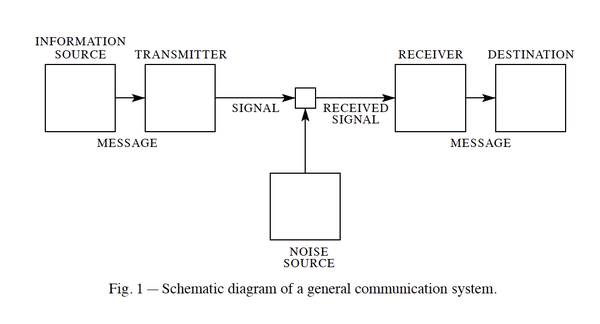User:Manetta/threeobjects
text : a Mathematical Theory of Communication, by Claude Shannon
(what) This article written by Claude Shannon in 1948[1], is known as the foundation of the information theory. It is the official mathematical paper written for an academic audience, which makes it quite hard for a non-academic reader to understand the author's ideas in detail. Shannon speaks about the influence that a transmission has on a message, at the moment that it is being transmitted from the source to its destination. This idea is structured through terms as 'information source', 'transmitter', 'channel', 'reciever' and 'destination'. Another interesting part of the text is the paragraph that speaks about the connection between a symbol and its frequency of appearence in the Englisch language. In the examples he uses in the text, Shannon presents the reader how a string of symbols is ordered, untill they appear in the correct order and present legible words.
(how) I got to know about this article through another article written by Angie Keefer, called Octopus in Plan View[2]. The different sources in the text present a broad range of differnt perspectives towards naming, describing and the influence that has on the content that is perceived.
(why) The way that technology and also language influences our perception, is a field that interests me. The very clear structure in Shannon's ideas are attractive, and fit the content that the text is speaking about very well. He divides his ideas up like it are mathematical formulas. The ideas that he discusses in this text are dated from 1948, but still relevent today.
Though I'm looking forward to read the popularized version of this text Recent Contributions to The Mathematical Theory of Communication, written by Warren Weaver in 1949.
- ↑ The text was published in 1949 in a book called 'THE mathematical theory of communication'. This shift from 'a theory' to 'the theory' is a small but significant element, which shows the importance of the text in that time.
- ↑ This text is published by the Serving Library, a NY based group of graphic designers/writers, working from the idea of a traveling library, producing its content on its way through collaborations and exhibitions.
Steve also strongly recommends: Gleick, James - The Information. A History. A Theory. A Flood He has an epub
The Historiographic Conceptualization
of Information: A Critical Survey (2008)
Bernard Dionysius Geoghegan
Northwestern University
Abstract by Geoghegan: "The historical pedigree and meaning of ‘‘information’’ has been hotly contested since its scientific definition in the 1940s. Scientists have authored very different explanations for the origins of informational research, the scope of information theory, and the historical significance of its findings. This survey classifies the historical literature into genres, offering a a view into the changing environment of computer research."
Steve notes: the 2 above texts are interesting to read together because the 1st offers what might be called the 'official' history of information, while the 2nd paper discusses how that history was constructed. Both are very interesting and informative
See also John Johnson's introduction to Kittler's essays (steve has pdf) in which he talks about 'discourse networks'.
See also: The Cybernetics Group by Steve Joshua Heims
Review by: Kevin J. Downing
Juju says:
- The Guttenberg Galaxy - Marshall McLuhan, printed media and its influence on human's consciousness
- If possible to find in German : Maurice Gex, Logique formelle
art piece : the Blackmarket for Useful Knowledge and Non-Knowledge
(what) 'The Blackmarket for Useful Knowledge and Non-Knowledge' is a project by the MobileAcademy, in which a divers range of experts is sharing their knowledge.
(how) The public is asked to sign up for a individual talk with one of them. As this conversation is recorded through microphones, the public can take a seat on the tribune, take a headphone, and be part of the conversation as a listener.
(why) The Blackmarket for Useful Knowledge and Non-Knowledge was part of the exhibition 'Too late, too little, (and how) to fail gracefully', curated by Bik van der Pol in the summer of 2011. It was presented in an old fort in Asperen (NL), a piece of architecture that used to protect the country. This all together brought a conversation around theme's as invaders and protection lines.
media object : XML file
(what) XML stands for 'Extensible Markup Language', a programming markup language developed in 1996, that is both human-readible as machine-readible. The design goals of XML emphasize simplicity, generality, and usability over the Internet.[1]
(how) In XML it is possible to define the type of content that is displayed, which is different in for example HTML. HTML does name the type of content as well, but on a higher level of abstraction. For example: a piece of text could be placed into a '< p >' tag, which tells any reciever that this text is a paragraph. In XML it is possible to use tags as <title>, <author>, <year>, <price>.
(why) This more specific way of wrapping the content creates more possibilities to give different commands to different types of content. Next to that, XML is designed to make a piece of code more readible, by using less 'noise' in the forms of many '<>' tags. I look forward to get to know more about the advantages of these Markup languages. I can imagine that this could lead to interesting results in a typographic translation of a XML written text (for example).
Antman Feedback:
- "In the accompaning examples, Shannon presents the reader how a string of symbols is ordered, untill they appear in the correct order and present legible words." I can't find the examples.
- Along what time scales do interactions occur between humans and technical objects, specifically networked and programmable machines? What are the implications of concatenating processual and measured time together in the context of digital technologies? What artistic and literary strategies explore this concatenation, and how does their mediation through networked and programmable machines affect the concatenation?

